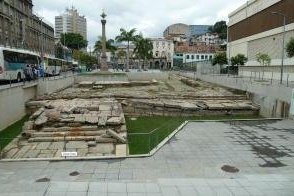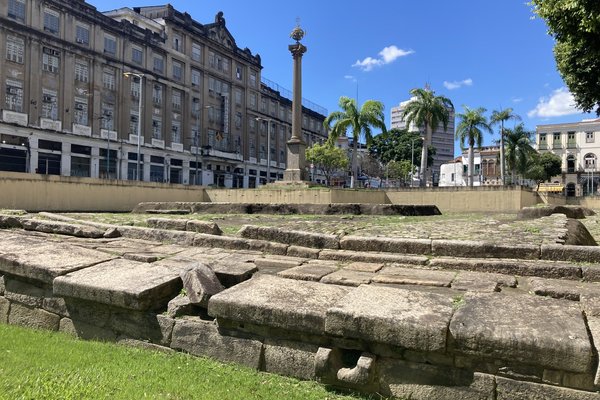Brazil
Valongo Wharf
Valongo Wharf Archaeological Site comprises the globally most significant remains of an arrival point of enslaved African persons in the Americas.
The wharf located at Rio de Janeiro’s Jornal do Comércio Square was built from 1811 onwards, and used until the construction of the Empress’ Wharf in 1843. About a quarter of all African American enslaved people to the Americas have arrived here. While its physical remains are modest (fragments of a pavement, a former road), its spiritual associations as a site of conscience for African Americans are strong.
Community Perspective: “The wharf used to jut out into the harbour, but it is now quite a way from the water and there isn't a whole lot to see.” And unless you are “emotionally attached to this place, what you will find is just a very underwhelming and poorly presented 10 minutes easy tick.”
Site Info
Official Information
- Full Name
- Valongo Wharf Archaeological Site (ID: 1548)
- Country
- Brazil
- Status
-
Inscribed 2017
Site history
History of Valongo Wharf
- 2017: Inscribed
- Inscribed
- Type
- Cultural
- Criteria
- vi
Links
- UNESCO
- whc.unesco.org
- Official
-
- rio.rj.gov.br — Info on the website of MUHCAB
- visit.rio — Official Rio Tourism website
- Related
-
- afroriowalkingtour.com — Afro-Rio Walking Tour
All Links
UNESCO.org
- whc.unesco.org — whc.unesco.org/
Official Website
- rio.rj.gov.br — Info on the website of MUHCAB
- visit.rio — Official Rio Tourism website
Related Resources
- afroriowalkingtour.com — Afro-Rio Walking Tour
Community Information
- Community Category
- Human activity: Transport and Trade
Travel Information
Rio de Janeiro Hotspot
Recent Connections
-
Perfect Inscriptions
2017 -
Dry Stone Construction
"..remains of a large building construc… -
Rio de Janeiro Hotspot
Downtown at Jornal do Comércio Square
Connections of Valongo Wharf
- Geography
-
-
Atlantic Ocean
entry port of transatlantic slave trade
-
- Architecture
-
-
Dry Stone Construction
"..remains of a large building constructed of ornamented masonry in eight layers. At present, these appear as drystone walls with occasional remnants of earth sediments." (AB ev)
-
- World Heritage Process
- Human Activity
-
-
Thanatourist destination
"It is a site of conscience, which illustrates strong and tangible associations to one of the most terrible crimes of humanity, the enslavement of hundreds of thousands of people creating the largest forced migration movement in history." (OUV) -
Slavery
strong symbolic reminder of the arrival of African enslaved labour on the South American continent. Following historical records, more than 900,000 enslaved persons arrived at this destination in the final decades of the transatlantic slave trade. (AB ev) -
Human Migration
" illustrates strong and tangible associations to one of the most terrible crimes of humanity, the enslavement of hundreds of thousands of people creating the largest forced migration movement in history" (OUV)
-
- Timeline
-
-
Built in the 19th Century
ancient wharf built for the landing of enslaved Africans from 1811 onwards
-
- WHS Hotspots
-
-
Rio de Janeiro Hotspot
Downtown at Jornal do Comércio Square
-
- Science and Technology
-
-
Recently discovered
In 2011, during the excavations carried out as part of the revitalization works in the Rio de Janeiro port area, the two wharfs - Valongo and Imperatriz - were discovered (wiki)
-
News
No news.
Recent Visitors
Visitors of Valongo Wharf
- Alberto Rodriguez Gutierrez
- Alejandro Lau
- Ammon Watkins
- Aspasia
- Atila Ege
- Bill Maurmann
- Carlo Sarion
- Carlos Sotelo
- Christine
- Christoph
- Christravelblog
- Colossus
- ctravel
- Cyberczar
- Danieljbromberg
- Dorejd
- Doubanjiang
- Els Slots
- Eva Kisgyorgy
- Felicité
- Frédéric M
- hotpickle
- Ian Cade
- Jan Zimmermann
- Jarek Pokrzywnicki
- João Aender
- Joel on the Road
- Jon Opol
- Karito Vies
- Ken DJ
- Kurt Lauer
- Little Lauren Travels
- Lucio
- Luis Filipe Gaspar
- Lukasz Palczewski
- Maciej Gil
- Michael Ayers
- Michael Novins
- Mikko
- Monica Tasciotti
- Nihal Ege
- Patrik
- Paul Schofield
- Pchxiao
- Philipp Leu
- Philipp Peterer
- phillipmeng
- rivr
- Roman Bruehwiler
- RYU
- Shandos Cleaver
- sibariam
- Slavi
- Ssong.x
- Stanislaw Warwas
- Szucs Tamas
- Tevity
- Thomas Buechler
- Thomas van der Walt
- Tim Allen
- Vernon Prieto
- Walter
- Wojciech Fedoruk
- Xiquinho Silva
- Yi Han Goh
- zfish
- Zoë Sheng
Community Reviews
Show full reviews
Time of visit: December 2020
Duration of visit: 15 minutes
Mode of transportation: by foot from the Royal Portuguese Reading Room
Review and experience
Valongo Wharf carries important historical significance, and in the wake of the race protests and discussions in the US - my home country - in 2020, visiting the site was an emotional and touching experience in the context of slavery, Africans in the Americas, and issues of race and class.
It intrigues me that Valongo Wharf is the smallest WHS site (as of writing in Nov 2021) and among the short list of sites selected only on Criterion VI (despite the committee's recommendation to use VI in conjunction with others). Among the several other slavery and indentured servitude sites in the VI-only list, Valongo felt forgettable and less "monumental" (amongst the giants of Goree and Auschwitz) as a reminder of the human atrocities. I struggle to identify another Cultural Criterion OUV that would be fitting for Valongo Wharf.
My poor rating comes not as a criticism of Valongo's historical significance, but rather the opposite - for a country so heavily influenced and defined by centuries of slavery, I was disappointed that this was a standalone slavery WHS for Brazil. Sites such as Paraty/Ilha Grande and Salvador already prominently focus on its relation to slavery in Brazil. Furthermore, the site felt not well protected, and there was only a single placard detailing a few paragraphs of history on the site. Compounded …
Keep reading 0 comments
Site visited just recently, March 2020. As it was already fully described by others I will add just one thing that was not underlined. Whoever visited that place prior 2011 had no chance to view the site by any means as the whole place looked completely different. By viewing google maps I found this: Google maps image
That is a view of Valongo Wharf as it looked in 2010. If the link is not working, try to place Pegman (this yellow man on Google maps) on the small unnamed road, just where the lettering of Praca Jornal do Comercio is located on the map. Instead of remnants of Valongo Wharfs you can see a street and parking place, all asphalted. Just imagine that 1-2 meters below the the surface there are ruins what is now called Valongo Wharf
Keep reading 0 comments
Visit: April 2019. Ian and Walter already covered the historical background and significance of this place. So I will stick to the more practical part. Unless you are a descendant of an African slave or in any other way emotionally attached to this place, what you will find is just a very underwhelming and poorly presented 10 minutes easy tick.
I visited in 2019, almost 2 years after inscription. Other sites with few to display (e.g. Jelling) make up for that with extensive information and an interpretation center for the lack of excitement. Valongo Wharf doesn’t. The information panels are old and don’t even wear the world heritage logo. The Wharf is part of an African heritage trail and somehow it’s not given more importance than the other five stops of the trail and you rather feel like you passed by accidentally. You need too much imagination to figure out how it once looked like. Finally you will do what we all do: take pictures from different angles, read the panels and leave after around 10 minutes. Luckily Rio is a nice city. Would this place be in a more remote place, far from other WHS, I doubt many would visit. The closest to compare this site with would be the Danube Limes site in Vienna.
To get there take the L1 tram and get out at Parada dos Navios. You can also walk along the seaside, taking the (far more eye catching) Mosteiro de Sao Bento TWHS …
Keep reading 0 comments
I visited this site on my first day in Brazil, as it is easy to reach, being in central Rio de Janeiro. I was not expecting much of it, and to be fair, it was a little underwhelming. As land has been reclaimed in the harbor, the Valongo wharf lies about 350 meters inland, and it is very difficult to imagine how it used to be. I usually don’t read too much about sites I plan to visit, trying to keep the excitement of the discovery intact. But for this site, it would have been better to research beforhand to better understand and enjoy the visit.It consists of part of the old stone wharf in the former harbour area of Rio de Janeiro, built for the landing of enslaved Africans reaching the South American continent from 1811 onwards. An estimated 900,000 Africans arrived in South America via Valongo. In fact, they were first landed in central Rio de Janeiro for Customs, and the moved on Bom Jesus Island for quarantaine. Only after quarantaine were they taken to Valongo to be sold in slaves markets.
The site is composed of an archeological window, through which two main archaeological layers can be seem. The lowest level consists of floor pavings in pé de moleque style (irregular cut stone set directly on the sand), attributed to the original Valongo Wharf. Built in 1811, it was more a paved beach and remained in use until 1831. In 1843, the original wharf was earthed …
Keep reading 0 comments
In brief, Valongo wharf (location) is the archaeological remains of the slave trading port in Rio which was one of the major points of entry of African slaves into the Americas.
The wharf used to jut out into the harbour, but it is now quite a way from the water and there isn't a whole lot to see. The small area of archaeological ruins lies on a newly constructed square in an otherwise unassuming part of central Rio next to a Hostpital. You can sort of make out a layout. Traces of walls give some perspective but you will need some extra input to make sense of what is a really interesting site, fortunately there are some multi lingual boards around the area to help.
This interpretation shows the utterly devastating history of the wharf which really hit home when you see the numbers of people involved. The information boards gave an estimate of 500,000 people that were sold/processed on this site, which was the final grand construction in a city where it is estimated that a fifth of all African slaves in the Americas docked. It was utterly staggering for us that this specific construction was initiated in 1811, four years after this barbarous act was outlawed internationally in the British Empire.
What struck us as extra strange was that this massive level of slavery took place in a city which presented the most multicultural face of any we had ever visited.
Whilst we appreciate we didn't …
Keep reading 0 comments
